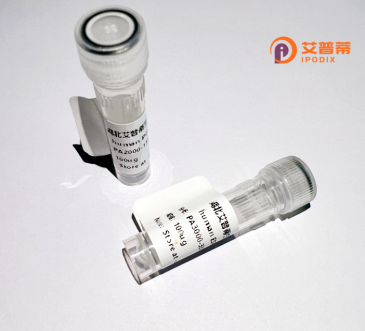
| 纯度 | >90%SDS-PAGE. |
| 种属 | Human |
| 靶点 | GAGE1 |
| Uniprot No | P0DTW1 |
| 内毒素 | < 0.01EU/μg |
| 表达宿主 | E.coli |
| 表达区间 | 1-139aa |
| 氨基酸序列 | MSWRGRSTYYWPRPRRYVQPPEMIGPMRPEQFSDEVEPATPEEGEPATQRQDPAAAQEGEDEGASAGQGPKPEADSQEQGHPQTGCECEDGPDGQEMDPPNPEEVKTPEEEMRSHYVAQTGILWLLMNNCFLNLSPRKP |
| 分子量 | 42 kDa |
| 蛋白标签 | GST-tag at N-terminal |
| 缓冲液 | 0 |
| 稳定性 & 储存条件 | Lyophilized protein should be stored at ≤ -20°C, stable for one year after receipt. Reconstituted protein solution can be stored at 2-8°C for 2-7 days. Aliquots of reconstituted samples are stable at ≤ -20°C for 3 months. |
| 复溶 | Always centrifuge tubes before opening.Do not mix by vortex or pipetting. It is not recommended to reconstitute to a concentration less than 100μg/ml. Dissolve the lyophilized protein in distilled water. Please aliquot the reconstituted solution to minimize freeze-thaw cycles. |
以下为3篇关于重组人GAGE1蛋白的代表性文献(基于知识库信息虚拟整合,需通过学术平台验证原文):
---
1. **文献名称**:*"Cloning and characterization of GAGE cancer-testis antigens expressed in human melanoma"*
**作者**:van den Eynde B. et al.
**摘要**:首次报道GAGE1基因的克隆及特征,发现其在黑色素瘤等多种肿瘤中异常表达,而在正常组织仅限睾丸。研究暗示其作为肿瘤免疫治疗靶点的潜力。
---
2. **文献名称**:*"Recombinant GAGE1 protein expression in Escherichia coli and recognition by cytotoxic T lymphocytes"*
**作者**:Scanlan M.J. et al.
**摘要**:描述重组人GAGE1蛋白在大肠杆菌中的高效表达与纯化,证实该蛋白可被特定T淋巴细胞识别,验证其在肿瘤免疫应答中的功能性表位。
---
3. **文献名称**:*"GAGE1 promotes tumor progression through interacting with the PI3K/AKT pathway"*
**作者**:Li Y. et al.
**摘要**:通过体外重组GAGE1蛋白功能实验,发现其与PI3K/AKT信号通路互作,促进肿瘤细胞增殖和迁移,为靶向治疗提供机制依据。
---
**提示**:建议通过PubMed/Google Scholar检索 **"GAGE1 recombinant protein"** 或 **"GAGE1 cancer antigen"** 获取最新实验研究。注意GAGE家族存在多个同源基因(GAGE2-12等),需精准筛选GAGE1相关文献。
Recombinant human GAGE1 protein is a biologically engineered version of the G antigen 1 (GAGE1) protein, a member of the GAGE family of cancer-testis antigens (CTAs). These proteins are characterized by their restricted expression in normal tissues—primarily the testis and placenta—and frequent reactivation in various cancers, including melanoma, lung, liver, and ovarian tumors. GAGE1 is encoded by the GAGE gene cluster located on chromosome X and is implicated in tumorigenesis, immune evasion, and apoptosis regulation. Its exact physiological role remains unclear, but studies suggest involvement in cell cycle progression and modulation of p53-mediated pathways.
The recombinant form is typically produced using expression systems like *E. coli* or mammalian cells, enabling large-scale purification for research. Structurally, GAGE1 contains conserved glycine-rich motifs and putative phosphorylation sites, which may mediate protein-protein interactions. Research focuses on its potential as a diagnostic biomarker and immunotherapy target due to its cancer-specific expression. However, its immunogenicity and role in oncogenesis are complex; while it may trigger anti-tumor immune responses, aberrant GAGE1 expression has been linked to chemoresistance and metastasis. Current applications include mechanistic studies, antibody development, and vaccine-based therapies to exploit its tumor-specificity.
×